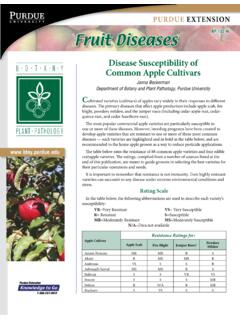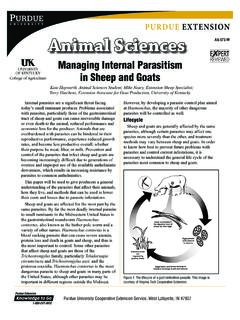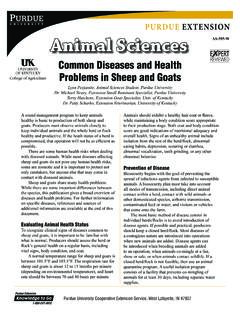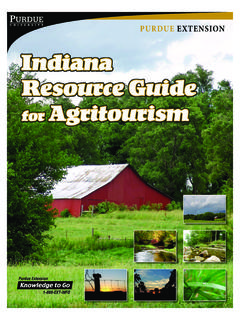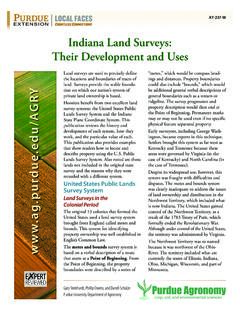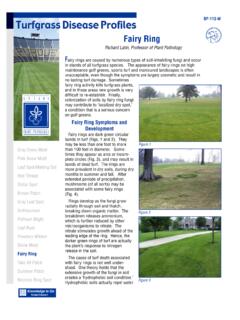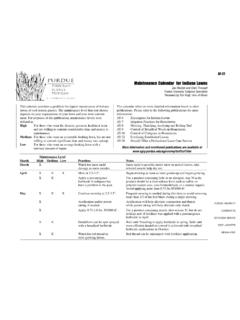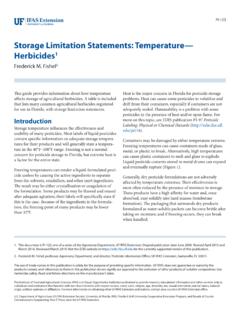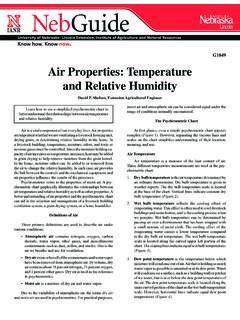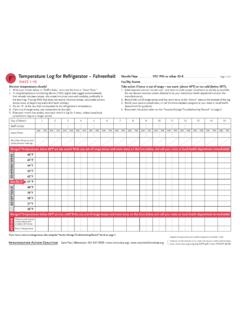Transcription of Temperature Requirements for Dogs - Purdue Extension
1 1 CENTER FOR ANIMAL WELFARE SCIENCE Requirements for Dogs Are they tailored to promote dog welfare?Mary Jordan, Amy E. Bauer, Judith L. Stella, Candace CroneyDepartment of Comparative Pathobiology, College of Veterinary MedicineIntroductionThe Temperature of the environment in which domestic dogs are housed can have positive or negative effects on their well-being. Federal regulations listed under the Animal Welfare Act include clauses to protect animals from extreme temperatures , but they do not take into account dog prefer-ences for Temperature or the diversity of body shapes and types within the species that may result in varying levels of tolerance for different temperatures . Several factors deter-mine the temperatures a dog experiences on any given day, and it is important to take them into consideration when evaluating dog housing and promoting dog Temperature recommendations for dog housingAnimal Welfare Act regulations require that indoor housing at research and breeding facilities must have adequate controls so that temperatures remain within the range specified for the species being kept (USDA, 2013).
2 Humidity must be maintained at levels of 30 to 70 percent (USDA, 2013) and ventilation must be sufficient to minimize odors, drafts, ammonia levels, and moisture condensation (USDA, 2013). Ambient Temperature , or the air Temperature surrounding the animal (USDA, 2013), must not fall below 10 C (50 F) for dogs not acclimated to lower temperatures (USDA, 2013) or rise above C (85 F) (USDA, 2013) for dogs in indoor facilities. Additionally, temperatures must never fall below C (45 F) or rise above C (85 F) for more than 4 consecutive hours. Although animal age, breed, overall health status and level of acclimation all come into play when determining optimal Temperature ranges, there are no recommendations or much scientific data that provide appropriate Temperature ranges as a function of those specific factors. Going back to basics: The science behind thermoregulation of dogs To determine more specifically the appropriate Temperature ranges for different breeds of dogs, and to ensure the welfare of kenneled dogs, it is important to understand dog physiology and how it is affected by Temperature .
3 Body Temperature is dependent on a balance between heat inputs from the internal and external environment and heat outputs (Klein, 2012). The ambient Temperature will determine the heat input from the external environment. If ambient Temperature exceeds the body Temperature , the dog will absorb heat from the environment (Klein, 2012). Heat loss through sweating from the feet and nose is minimal, and as ambient temperatures rise above 31 C ( F), heat is no longer lost through the skin (Stanley, 1980). As temperatures approach or exceed the dog s body Temperature , heat loss by evaporation through panting becomes the only available means by which the dog can cool itself (Klein, 2012). It should be noted that increased humidity, dehydration, confinement in closed spaces with poor ventila-tion, and upper respiratory tract complications, such as being brachycephalic (short-nosed, like a bulldog, pug or boxer) can all impede the effectiveness of panting (Drobatz, 2015). 2 Temperature Requirements for Dogs The normal range of temperatures at which dogs and other species can maintain their body temperatures without expend-ing energy to increase heat production or heat loss (NRC, 2010) is called the thermoneutral zone (TNZ), and ranges from 20 C (68 F) to 30 C (86 F) for dogs (NRC, 2006).
4 Outside of the TNZ exist the upper and lower critical tem-perature zones. When temperatures are in these zones the dog has to expend energy to maintain its body Temperature . When this is no longer possible, hypo- or hyperthermia occurs. It is important to consider coat thickness and other specific breed or individual properties when assessing the upper and lower critical temperatures for dogs. For example, the lower critical Temperature of healthy adult Siberian huskies is less than 0 C (32 F) (NRC, 2006), but in some short-haired dogs it is 15 C (59 F) (Sjaastad, 2010). Likewise, due to their anatomy, brachycephalic breeds expend more energy breathing and have a reduced capacity to release heat by panting than do dogs with intermediate muzzle:head proportions (mesocephalic breeds) (Drobatz, 2015). Also, puppies, geriatric dogs and sick animals have a reduced capacity to maintain their body Temperature (NRC, 2006). Therefore, higher temperatures may be neces-sary for their thermal comfort and overall well-being (CCAC, 1993).
5 Lastly, it is important to be aware that enclosure size and number of enclosures present in the facility may result in the effective ambient Temperature near the dog differing from the Temperature of the room as a whole (NRC, 2010). Addi-tional factors, including the composition and color of the substrate on which the animal is housed (Morgan and Trom-borg, 2007) and the number of dogs per enclosure, also influence the effective ambient the Regulations to DogsWhile regulations on acceptable Temperature ranges for dogs exist, tailored, more specific management practices are neces-sary in order to promote the well-being of all breeds, life stages and physical conditions of dogs. For example, brachycephalic dogs, which represent four of the top 10 most popular regis-tered breeds in America (AKC), need special consideration. Brachycephalic breeds have wide, shortened heads (Schwarz and Saunders 2011). Due to a number of congenital and secondary acquired abnormalities (narrowed nostrils, abnormal growth of trachea), they must work against the increased resistance in their airways to breathe and cannot effectively disperse heat by panting, resulting in heat and exercise intoler-ance (Meola, 2013, Roedler et al.)
6 , 2013). Consequently, when maintained at the same Temperature , mesocephalic breeds, or those with heads of medium proportions (Schwarz and Saunders 2011), may experience good welfare while brachyce-phalic breeds may have difficulty coping. Another group of dogs needing special consideration for Temperature ranges are those with extremes in coat type, both those with particularly thick coats, such as Siberian Huskies, and those with thin to absent coats, such as Chinese Crested dogs. Thicker coats decrease heat loss from the skin (Johnson et al., 2006). Without proper attention, such dogs may face thermal distress at higher temperatures than might be accept-able for other dogs. Dogs with thin to absent fur have less capacity to retain heat and may not tolerate low temperatures well. It is also important to pay attention to fur color; darker coats tend to absorb more heat (Johnson et al., 2006). Lastly, the size of the dogs housed must be considered as smaller dogs (with greater surface area to volume ratios) lose heat faster (Rigotti et al.
7 , 2015) and, due to the insulating effects of fat, obese animals cannot cool off as well (Johnson et al., 2006). Finally, the importance of allowing dogs some means by which to cope with the thermal environment in which they live cannot be overstated. It is necessary to provide options for dogs to cope with both cold and heat stress, and to behav-iorally thermoregulate by changing postures, seeking shelter from weather, being provided bedding and heated or cooled areas in kennels and homes, or being housed in facilities designed with the ability to control the Temperature of individual quarters (Loveridge, 1998). It is important to implement these methods into kennel care because having some control over the environment can positively affect an animal s welfare (CCAC, 1993). Additionally, if animals are to be exposed to temperatures outside the TNZ, they should be acclimated prior to exposure (CCAC, 1993). This allows 3 Temperature Requirements for Dogs It is the policy of the Purdue University Cooperative Extension Service that all persons have equal opportunity and access to its educational programs, services, activities, and facilities without regard to race, religion, color, sex, age, national origin or ancestry, marital status, parental status, sexual orientation, disability or status as a veteran.
8 Purdue University is an Affirmative Action institution. This material may be available in alternative 2016 Order or download materials from Purdue Extension The Education to adapt to the Temperature , therefore reducing distress. Acclimation takes time, however. For example, partial acclimatization in small animals can require from 10 to 20 days; full acclimatization takes 60 days (Johnson et al., 2006). Thus, acclimatization time should be planned for when changes in ambient Temperature are expected to and Future Considerations Current regulations on Temperature for dog housing are typically presented as general ranges for the species. However, due to variations within the species, there is a need for research on the Requirements and preferences of specific breed types and factors that can affect Temperature preferences and actual temperatures experienced by dogs. Improvement in these areas will benefit the welfare of dogs housed within facilities.
9 In the medical and veterinary medical communities, it is recognized that evidence-based medicine should be the standard of practice. Basing policy development on sound science should also be the standard of practice for legislation to ensure its role in upholding welfare. ReferencesAmerican Kennel Club (AKC) Most Popular Dog Breeds in America. Available at Accessed June 2, , 1993. Guide to the Care and Use of Experimental , , 2015. Chapter 149, Heat Stroke. Small Animal Critical Care Medicine. 2nd Edition. Elsevier. Johnson, , McMichael, M., White, G., 2006. Heatstroke in small animal medicine: a clinical practice review. Journal of Veterinary Emergency and Critical Care 16(2), , , 2012. Chapter 53: Thermoregulation. Cunning-ham s Textbook of Veterinary Physiology. 5th Edition. , , 1998. Environmentally enriched dog housing. Applied Animal Behaviour Science 59, 101-113. Meola, , 2013. Brachycephalic Airway Syndrome. Topics in Companion Animal Medicine 28, 91-96.
10 Morgan, , Tromborg, , 2007. Sources of stress in captivity. Applied Animal Behaviour Science 102, Research Council, 2006. Nutrient Requirements of Dogs and Cats. National Academies Press, Washington, Research Council, 2011. Guide for the Care and Use of Laboratory Animals: Eighth Edition. National Academies Press, Washington, , , Jolliffe, , Leece, , 2015. Effect of prewarming on the body Temperature of small dogs undergo-ing inhalation anesthesia. Journal of the American Veterinary Medical Association 247, , , Pohl, S., Oechtering, , 2013. How does severe brachycephaly affect dog s lives? Results of a structured preoperative owner questionnaire. The Veterinary Journal 198, , T., Saunders, J., 2011. Veterinary Computed Tomog-raphy. John Wiley & Sons. Sjaastad, , Hove, K., Sand, O., 2010. Physiology of Domestic Animals. 2nd Edition. Scandinavian Veterinary , , 1980. A Study of Heat Stroke and Heat Exhaus-tion in the Dog. Iowa State University Veterinarian 42, , 2013.
